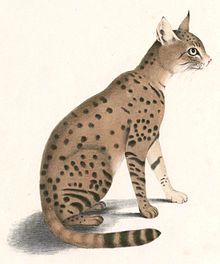Asiatic wild cat
| Asiatic wild cat | ||||||||||||
|---|---|---|---|---|---|---|---|---|---|---|---|---|

An Asiatic wildcat in Rajasthan |
||||||||||||
| Systematics | ||||||||||||
|
||||||||||||
| Scientific name | ||||||||||||
| Felis lybica ornata | ||||||||||||
| Gray , 1830 |


The Asian wildcat ( Felis lybica ornata ( Syn .: Felis silvestris ornata )), also known as the steppe cat , is a subspecies of the wildcat that occurs in Iran, in some areas in Afghanistan, Pakistan and India and in large parts of Central Asia .
features
The length from head to tail is 47 to 74 cm, the tail length 22 to 36 cm and the weight of the Asiatic wildcat is usually 2 to 6 kg. The animals are light sand-colored, gray or isabel-colored and the fur is more or less patterned with small or larger brownish or gray spots. The spots are sometimes connected to form strips, especially in steppe cats that live east of the Tian Shan in Mongolia and China. Compared to the African black cat, a dot pattern is more common than a stripe pattern in the Asian wildcat. Every now and then the spots form a dark line along the middle of the back. The ventral side is whitish and unspotted. The tail is long and thin, spotted at the base and curled near the always black end. They have a small brush of fine dark hair on both tips of their ears. The backs of the ears are yellowish or khaki in color . There are one or two dark circles on the upper part of the front and rear legs. They differ from the similar African wildcat in their dotted rather than striped fur pattern. Compared to the house cat, the Asiatic wildcat has a longer body, tail, and legs. It differs significantly from the European wildcat in the morphometry of the skull.
distribution and habitat
It is widespread from Iran to western India and Central Asia, where it penetrates to northwest China and Mongolia. The limit of distribution between the European wildcat and the Asian wildcat is formed by the Caucasus . In the deserts of western Rajasthan it lives in thickets of acacia , caper bushes ( Capparis ), prosopis and tamarisks ( Tamarix ), in Tajikistan , Turkmenistan and Uzbekistan in bushland with saxaul , tamarisks and various shrub-like salt plants and in Kazakhstan it comes along on the banks Reeds existed in lakes and rivers and inhabited bushy areas on the slopes of the Tian Shan Mountains up to heights of 2000 meters.
Way of life
Asiatic wildcats are solitary and nocturnal in the hot south of their range. They spend the day in hiding. In Central Asia they are more active at twilight or can be active at all times of the day. Asiatic wildcats feed primarily on smaller rodents, but on occasion also catch hares or rabbits , poultry or other birds that spend a lot of time on the ground, e.g. B. pigeons, birds and pheasants , as well as lizards, snakes, scorpions, large beetles and other insects. Rodents that are preyed on include the house mouse , muskrat , jerboa , racing rats, and gerbils . They also kill snakes that are dangerous to them, such as cobras , sand-rattle otters, or sand boas . In Central Asia, Asiatic wildcats mate in January and February, in Northwest India in November and December, and in March and April.
natural reserve
The Asian wildcat is listed in Appendix II of the Washington Convention on Endangered Species . In the Red List of IUCN it is not performed separately. In the past many animals were killed for their fur, nowadays to protect the poultry. For most of the states in the distribution area of the Asiatic wildcat, the population is not known. In India the animals have lost around 90% of their previous habitat. Many are also killed by stray or feral domestic dogs.
Individual evidence
- ↑ Kitchener AC, Breitenmoser-Würsten Ch., Eizirik E., Gentry A., Werdelin L., Wilting A., Yamaguchi N., Abramov AV, Christiansen P., Driscoll C., Duckworth JW, Johnson W., Luo S. .-J., Meijaard E., O'Donoghue P., Sanderson J., Seymour K., Bruford M., Groves C., Hoffmann M., Nowell K., Timmons Z. & Tobe S. 2017. A revised taxonomy of the Felidae. The final report of the Cat Classification Task Force of the IUCN / SSC Cat Specialist Group. Cat News Special Issue 11, 80 pp. Pages 17–20.
- ^ A b c d e Mel E. Sunquist & Fiona C. Sunquist: Family Felidae (Cats). Page 165 and 167 in Don E. Wilson , Russell A. Mittermeier : Handbook of the Mammals of the World - Volume 1 Carnivores. Lynx Editions, 2009, ISBN 978-84-96553-49-1
- ^ CP Groves: The Chinese mountain cat (Felis habeni). In: Carnivore. 3 (3), 1980, pp. 35-41.
- ↑ Nobuyuki Yamaguchi, Carlos A. Driscoll, Andrew C. Kitchener & Jennifer M. Ward: Craniological differentiation between European wildcats (Felis silvestris silvestris), African wildcats (F. s. Lybica) and Asian wildcats (F. s. Ornata): Implications for their evolution and conservation. Biological Journal of the Linnean Society, 2004, 83, 47-63, DOI: 10.1111 / j.1095-8312.2004.00372.x